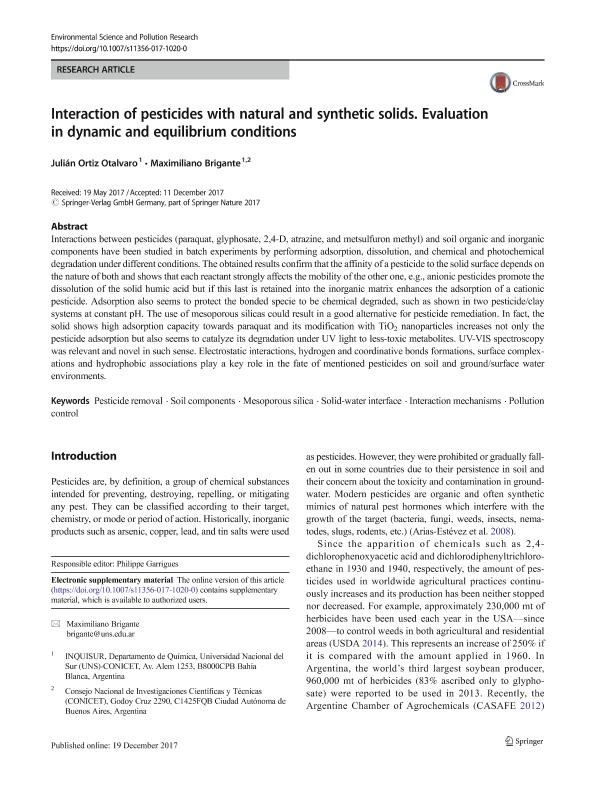Mostrar el registro sencillo del ítem
dc.contributor.author
Ortiz Otalvaro, Julian Andres

dc.contributor.author
Brigante, Maximiliano Eduardo

dc.date.available
2018-08-23T17:53:38Z
dc.date.issued
2018-03
dc.identifier.citation
Ortiz Otalvaro, Julian Andres; Brigante, Maximiliano Eduardo; Interaction of pesticides with natural and synthetic solids. Evaluation in dynamic and equilibrium conditions; Springer Heidelberg; Environmental Science and Pollution Research; 25; 7; 3-2018; 6707-6719
dc.identifier.issn
0944-1344
dc.identifier.uri
http://hdl.handle.net/11336/56832
dc.description.abstract
Interactions between pesticides (paraquat, glyphosate, 2,4-D, atrazine, and metsulfuron methyl) and soil organic and inorganic components have been studied in batch experiments by performing adsorption, dissolution, and chemical and photochemical degradation under different conditions. The obtained results confirm that the affinity of a pesticide to the solid surface depends on the nature of both and shows that each reactant strongly affects the mobility of the other one, e.g., anionic pesticides promote the dissolution of the solid humic acid but if this last is retained into the inorganic matrix enhances the adsorption of a cationic pesticide. Adsorption also seems to protect the bonded specie to be chemical degraded, such as shown in two pesticide/clay systems at constant pH. The use of mesoporous silicas could result in a good alternative for pesticide remediation. In fact, the solid shows high adsorption capacity towards paraquat and its modification with TiO2 nanoparticles increases not only the pesticide adsorption but also seems to catalyze its degradation under UV light to less-toxic metabolites. UV-VIS spectroscopy was relevant and novel in such sense. Electrostatic interactions, hydrogen and coordinative bonds formations, surface complexations and hydrophobic associations play a key role in the fate of mentioned pesticides on soil and ground/surface water environments.
dc.format
application/pdf
dc.language.iso
eng
dc.publisher
Springer Heidelberg

dc.rights
info:eu-repo/semantics/openAccess
dc.rights.uri
https://creativecommons.org/licenses/by-nc-sa/2.5/ar/
dc.subject
Interaction Mechanisms
dc.subject
Mesoporous Silica
dc.subject
Pesticide Removal
dc.subject
Pollution Control
dc.subject
Soil Components
dc.subject
Solid-Water Interface
dc.subject.classification
Otras Ciencias Químicas

dc.subject.classification
Ciencias Químicas

dc.subject.classification
CIENCIAS NATURALES Y EXACTAS

dc.title
Interaction of pesticides with natural and synthetic solids. Evaluation in dynamic and equilibrium conditions
dc.type
info:eu-repo/semantics/article
dc.type
info:ar-repo/semantics/artículo
dc.type
info:eu-repo/semantics/publishedVersion
dc.date.updated
2018-08-21T13:04:56Z
dc.journal.volume
25
dc.journal.number
7
dc.journal.pagination
6707-6719
dc.journal.pais
Alemania

dc.journal.ciudad
Heidelberg
dc.description.fil
Fil: Ortiz Otalvaro, Julian Andres. Consejo Nacional de Investigaciones Científicas y Técnicas. Centro Científico Tecnológico Conicet - Bahía Blanca. Instituto de Química del Sur. Universidad Nacional del Sur. Departamento de Química. Instituto de Química del Sur; Argentina
dc.description.fil
Fil: Brigante, Maximiliano Eduardo. Consejo Nacional de Investigaciones Científicas y Técnicas. Centro Científico Tecnológico Conicet - Bahía Blanca. Instituto de Química del Sur. Universidad Nacional del Sur. Departamento de Química. Instituto de Química del Sur; Argentina
dc.journal.title
Environmental Science and Pollution Research

dc.relation.alternativeid
info:eu-repo/semantics/altIdentifier/url/https://link.springer.com/article/10.1007/s11356-017-1020-0
dc.relation.alternativeid
info:eu-repo/semantics/altIdentifier/doi/http://dx.doi.org/10.1007/s11356-017-1020-0
Archivos asociados
